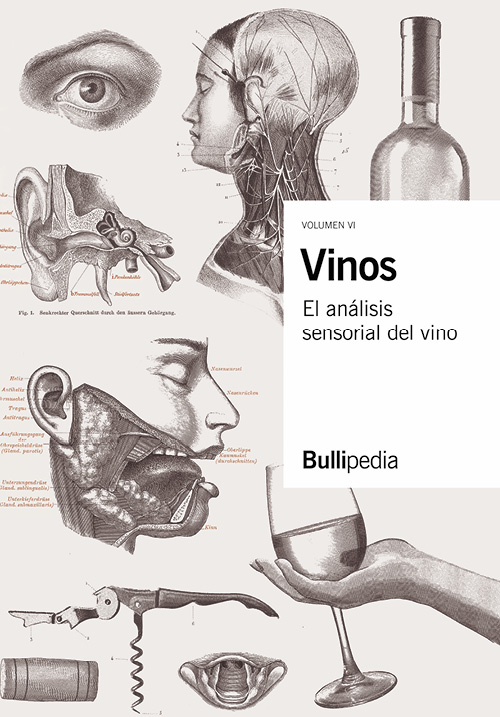Vinos. Del mercado a la carta (Volumen III)
Wines. From market to wine list is the third volume of Wine Sapiens in Bullipedia.
This book examines the journey that a wine takes from the winery up to its appearance on a restaurant menu: detailing aspects such as exportation, transport logistics, the pricing of the wine, factors determining the restaurant offer, the sommelier’s role in purchasing the wine, and the wine list. Likewise, we explore in depth the most relevant factor influencing the sommelier to buy a particular wine: the quality of the product.
In taking this tour of the world of wine, we have the privilege of being accompanied by some of the best sommeliers on the planet, whose experience and knowledge enriches this volume.
528 pages
230 x 330 mm
Hard cover
ISBN: 978-84-09-13710-7
COMPLETE THE WINE SERIES...

Following the successful publication of Volume I and II of Wine Sapiens: Viticulture and the contextualization of wine (Vol I) and Winemaking and classifications (Vol II), comes the third volume: From market to the wine list (Vol III).
Picture a customer sitting at the restaurant table studying the wine list. Upon arriving at a decision, he orders and, shortly afterwards, finds himself sampling the wine. In order for this scenario to take place, a chain of five distinct steps is required, in which the product is taken from the vineyard into the winery itself. Then, it is sold to a distributor, who in turn resells it to a restaurant. Finally, the product is offered and served to a diner.
This book aims to explore these steps by asking questions related to distribution and the motives that lead purchasing managers and sommeliers to buy a particular bottle. How do wine markets work? How is wine transported from one place to another? What factors provide the necessary value for a wine to be attractive in the eyes of the consumer? How is the price of a bottle set? How does the law of supply and demand work?
Following the interactions of the market, the sommelier comes into the picture, occupying centre stage in the Wine Sapiens.
Nine renowned sommeliers feature in our pages, offering practical explanations throughout the book: Enrico Bernardo, María José Huertas, Andy Myers MS, Agustí Peris, Antoine Pétrus, Josep “Pitu” Roca, Arvid Rosenger, Ronan Sayburn MS and David Seijas.
Guided by this expertise, we look at the fine dining gastronomic restaurant and analyse the more than a hundred conditions that impact on the wine offer. Then, we explain the different reasons that lead to the selection of the wine that forms the menu, discussing how bottles should be bought and managed. Moreover, leading sommeliers all agree that the most important factor in deciding on a wine is quality, but how do we measure this attribute? Why are some wines considered better than others? Is it just a question of taste, or does the brand, exclusivity and price also influence the perception of quality?
In this volume we delve deeper into the wine list, the basic way in which all quality restaurants present their wine selection. We look at how it is drawn up, going beyond just being a simple list and taking into account concepts such as ease of use, product diversity and price fairness in order to create an effective menu. Lastly, even the finest bottle loses its value if it is not properly preserved. Any good sommelier must understand how to preserve and age some of the wines that are acquired. To this end, the final chapter of the book explores the secrets of aging wine within the restaurant.
In this section is a short summary of each chapter of the book
Download in PDF
CHAPTER 1
INTRODUCTION TO THE WINE MARKET
Continue reading >

CHAPTER 2
LOGISTICS AND WINE TAXATION
Continue reading >

CHAPTER 3
THE PRICE OF WINE
Continue reading >

CHAPTER 4
THE VALUE OF WINE
Continue reading >

CHAPTER 5
THE FINE DINING GASTRONOMIC RESTAURANT AND ITS SELECTION OF DRINKS
Continue reading >

CHAPTER 6
CONSTRAINTS ON THE SELECTION OF DRINKS
Continue reading >

CHAPTER 7
BUYING WINE IN THE RESTAURANT
Continue reading >

CHAPTER 8
THE QUALITY OF THE WINE
Continue reading >

CHAPTER 9
THE WINE LIST
Continue reading >

CHAPTER 10
THE CONSERVATION OF WINE WITHIN THE RESTAURANT
Continue reading >

The first complete encyclopaedia on wine. A multidisciplinary work based on the Sapiens method, a revolutionary research method that brings together scientists, maître d’s, historians, artists, sommeliers, graphic designers and many more professionals associated with the world of wine.
El Economista

This book takes us through the differing aspects of the market for wine, focusing on distribution and considering what motivates buyers and sommeliers to purchase a bottle. A project by sommelier Ferran Centelles with the help of Vila Viniteca
La Vanguardia

A total of nine sommeliers (Ronan Sayburn MS, Agustí Peris, Andy Myers MS, María José Huertas, Enrico Bernardo, Josep ‘Pitu’ Roca, Antoine Pétrus, Arvid Rosenger and David Seijas) participate in this volume offering practical examples
7 Caníbales


































